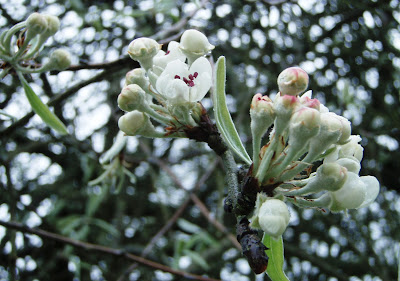 |
| A Lovely Big hedgerow Apple Tree |
Now is the easiest time to spot fruit trees in the hedgerows and parks and common land, even if you do not have much knowledge of tree types. This weekend we stopped under a small but florid crab apple tree to shelter from the April rain (this is certainly the wettest drought I’ve ever seen). The prolific buzzing of bees in the canopy made a welcome change from the constant background drone of traffic.
 |
| A Great Spot For A Picnic; by a Canal, with Free Fruit and Walnuts |
Apple and pear trees are coming into bloom and the blossom will be abundant, which is why, like, Cherries, they are sometimes planted as ornamental trees.
 |
| Apple |
Many countries celebrate the flowering of fruit trees in Spring. It is a time of rejuvenation and transformation.
 |
| Pear |
So, when you next spot a tree covered in flowers, take time to look a little closer and see if you can identify what fruit it will bear.
 |
| Apple |
Structurally, apple and pear trees can look similar although pears tend to be taller and more upright in their growth. Apple trees often show signs of previous pruning but if they have been neglected they can get very gnarled and busy.
 |
| Apple |
The flowers of pear trees do look similar and both trees begin to grow leaves before flowers but the buds of apple blossom are often tinged with pink; whereas pears are likely to be pure white
The easiest way to determine apple from pear, before the fruit is visible, is by examining the leaves. Pear leaves are more pointed in shape and have a more sharply serrated edge. Apple leaves have more gentle serrations around the edges and a more rounded appearance.
 |
| Pear |
Of course there are many diverse varieties within any type of fruit tree, so differences will always need to be accounted for. The Urbane Forager’s free Seasonal id Sheets are still available for download to your computer and printing off for convenience…

No comments:
Post a Comment